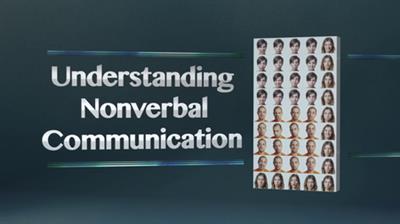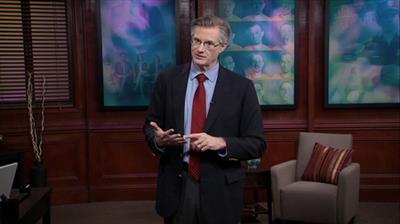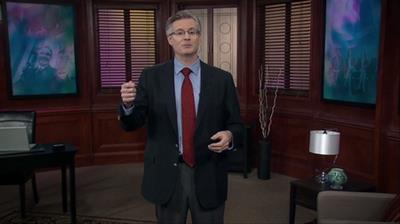
TTC Video - Understanding Nonverbal Communication
12xWEBRip | English | MP4 + PDF Guide | 1280 x 720 | AVC ~1904 kbps | 29.970 fps
AAC | 96 Kbps | 44.1 KHz | 2 channels | 06:11:21 | 5.22 GB
Genre: eLearning Video / Psychology, Self Improvement
Posture. Eye contact and blinking. Gestures. Tone and pitch. Gait. Body type and clothing choices. How much of our communication is nonverbal? Many people have heard the claim that 93% of what we express is conveyed through nonverbal communication. After a study in the 1960s, this idea spread into mainstream thinking and changed the way we viewed and interpreted our interactions with others.
In Understanding Nonverbal Communication, you'll discover that nonverbal communication is less intentional and harder to control than the words you choose to speak, and you are less aware of it than you are of your words, so it provides better clues to what you are feeling and thinking. You can deliberately decide what to say, but from the deeper subcortical regions of your brain come your involuntary nonverbal expressions, including changes in blood pressure, sweat, pupil dilation, increased heart rate, facial movements, or blushing cheeks-any of which can speak more about your intentions or emotions than your actual words might. In 12 revealing lectures, you'll explore the history, evolution, and context of both the outright obvious and the sublimely subtle nuances of personal expression.
Interestingly, the 93% statistic mentioned above is not accurate-it's impossible to truly quantify every nuance of nonverbal communication. Regardless, what made this study so important was the revelation that recognizing and correctly interpreting nonverbal expressions is essential to fully understanding how people communicate. Once begun, the study of nonverbal communication was embraced by psychologists, communication scientists, sociologists, anthropologists, ethologists, biologists, and even political scientists and economists. The science of nonverbal communication has revealed intriguing insights into everything from how aspects of your reactions are biologically hardwired to how you are subconsciously influenced to vote by political speakers, and even to predicting relationship status-whether people are attracted to each other and the likelihood that they will stay together.
Throughout this course, you will explore the role of nonverbal communication as it relates to understanding other people's worldviews and interaction styles. With careful observation, you can capitalize on this science to further appreciate human expression, smooth social interactions, and strengthen relationships-helping to make the world a better and more accepting place.
There is certainly no lack of resources for information about nonverbal communication; however, very little of what you will come across is based on systematic studies. This course will view the scope of nonverbal communication through the lens of science, led by Dr. Mark Frank, Professor and Department Chair of the Department of Communication and the Director of the Communication Science Center at the University at Buffalo, The State University of New York. From what you choose to wear to how fast you walk, you're consciously and unconsciously sending messages about yourself, your beliefs, and your personality, and we are consciously and unconsciously receiving these signals and making assumptions about you. This course provides the scientific analysis of the message being sent and how it is received.
Nonverbal Communication: Vital to Survival
One of the most fascinating aspects of this course is the in-depth research Dr. Frank reveals around the biological and anthropological aspects of nonverbal communication. He demonstrates how our endurance as a species can be directly tied to how our ability to present our intentions has evolved.
Like many other animals, we primarily live in social groups. Dogs live in packs, elephants in herds, and chimpanzees and bonobos-our closest relatives-are very social animals. None of these animals speak, yet they can communicate about danger, social status, friendliness, and so forth. Further, scientists have found that the throat anatomy of the skeletons of non-Homo sapiens suggests that some human ancestors were not capable of articulate speech, either. The anatomy of early human remains demonstrates a lack, or alternative location, of the hyoid bone, making the larynx (our voice box) so small that speech was rendered impossible. Our ancestors' throats resembled those of chimpanzees, and scientists have demonstrated that you cannot teach a chimp to "speak" beyond a limited number of sounds. Our ancestors, as early as 100,000-200,000 years ago, were strictly nonverbal creatures. Because that is not a large time frame on an evolutionary scale, scientists believe this is why the nonverbal parts of our communication are still with us.
The most common human expressions are a result of our drive to demonstrate our intent so others can coordinate similarly appropriate reactions. The emotions conveyed in our facial expressions and body language can indicate that we want to prevent conflict or initiate it, demonstrate hierarchy, signal danger, invite others to approach, or ask for help. The following basic emotions are communicated most strongly through our faces, and to a lesser degree in our voices:
Anger - signals attack; allows others to back off and prevent conflict
Contempt - signals status; groups with clear status hierarchies are more stable
Disgust - signals bad food; shows others what not to eat
Fear - signals danger; others can see and adjust their behavior accordingly
Happy or enjoyment - signals approachability
Sad or distress- signals something is wrong, needs attention
Surprise - signals something novel, trains attention to figure out what it is
The particular pattern of these expressions is universal across all human beings. Even our most base instincts are illustrated with nonverbal communication: When presented with a challenge, a simple facial expression or change in posture and stance can let our friends and foes know if we are about to fight due to anger or take flight due to fear. Nonverbal communication is thus essential to survival-survival of the individual and survival of the group.
The Human Lie Detector Is A Lie
Many people have high levels of confidence in their abilities to read other people. We understand that others can say what they will about what they think or feel, but we often scrutinize them and observe the subtleties in their behavior for clues that may tell us what's really going on. If you've ever watched a high-stakes poker game, you may see the players analyzing each other's expressions and nervous tics for "tells" about whether they have good hands or they are bluffing. And, in fact, one of the most common reasons people try to read each other is to determine sincerity. Is it true that everybody lies? Alas, yes. Studies have shown that we all tend to tell 1-2 lies every day. Dr. Frank jokes that 99% of people have admitted to telling a lie, and the remaining 1% are liars.
With the plethora of TV shows about human lie detectors, many people consider themselves experts in being able to read a person who is not being truthful. Sadly, those shows are mostly fictional as well, and Dr. Frank is a perfect expert to debunk these myths. His work has examined the behaviors associated with real versus falsified emotions, behaviors that occur when people lie, and the factors that make people better or worse judges of emotion and deception. His work has been funded by The National Science Foundation, the U.S. Department of Homeland Security, the U.S. Department of Defense, and the intelligence community. He has published numerous research papers analyzing deception, facial expressions, emotion, and violence in real-world contexts. He has also coedited two books on the subject. An outstanding expert in this field, his conclusion is that there is no behavior that guarantees that a person is lying.
One of the reasons for this is that nonverbal communication consists of a variety of different signals emanating from the face, the eyes, the movements of the shoulders, the hands, the fingers, the body, the voice tone, and the speaking style. Trying to capture this in a single test is quite difficult. Furthermore, every person is unique, and signs associated with telling a lie will manifest differently from person to person. Some may sweat, others may not maintain eye contact, or the eyes will roll a certain direction, or they will blink excessively, and still others may have verbal tics such as stuttering or babbling. However, when lying, a different set of people may relay a story with a calm and collected demeanor, they may maintain perfect eye contact, and they may tell a concise and short story, avoiding as many extra words as possible. All of these behaviors can be signs of other things besides lying, such as thinking on one's feet, and are not guaranteed proof that a person is lying.
Even if you were to focus on just the facial expression, accurate and generalizable analysis is a daunting task to perfect. Darwin undertook one of the earliest attempts to study this facet of social science in the late 1800s. Since then, there have been over 100 studies examining the ability of people to judge others' emotions from facial expressions. When it comes to recognizing the basic facial expressions such as anger, contempt, disgust, fear, happiness, sadness, and surprise, scientist find that people tend to recognize the correct emotion at rates greater than 80%. But when it comes to recognizing deceit, we will never be perfect, because all of the mechanisms that we employ to conceal, fabricate, or feel can happen for reasons other than lying.
The Global Benefits of Understanding Nonverbal Communication
Being able to read people better has all sorts of advantages beyond just confirming truth. Research shows that those who are better at reading others are able to maintain more harmonious relationships. They often receive better evaluations from their supervisors in the workplace. Salespeople who can read their customers better get more sales. Police officers who are better at reading people get more confessions that are upheld in court. Reading nonverbal communication gives you the ability to anticipate problems, and thus adjust your behaviors to head those minor problems off before they turn into major problems.
There are a number of simple tools you'll learn from Dr. Frank that can help you improve your ability to interpret nonverbal communication. For example, observe your interpersonal relationships, and those of others. You will be surprised what you see when you simply look and listen, without speaking. Dr. Frank notes that Yogi Berra said it best: "You can observe a lot by watching."
Dr. Frank is careful to point out there is no magic technique that will allow you to know everything a person is thinking just by their expression. Add to this is the dilemma that people around the world just do things differently. Avoiding eye contact is considered rude in many Western cultures, while it's considered rude to make eye contact in some Eastern cultures. In some societies, shaking your head from side to side means yes, while nodding your head up and down means no. As George H. W. Bush unfortunately learned in 1992, a hand gesture meaning peace in the U.S., when turned around, is an obscene gesture in Australia. Different cultures have different rules to regulate their nonverbal communication. Because many of our nonverbal reactions are so automatic and done without thinking, we tend to believe that the rules that regulate the nonverbal communication we use are normal. Deviations from those rules result in us feeling lost and very self-conscious, as well as suspicious of those who violate those rules.
Despite the many cultural differences between people across the world, the reality is that when it comes to basic communication, we are all really much more similar than we are different. We have an evolutionary, built-in common platform for understanding in our feelings and our emotions. We share a wonderful biological-psychological legacy that lives in us today. By understanding our shared heritage and learning how to better interpret nonverbal communication, you have a launching point for shared understanding, cooperation, and kindness-all of which results in a better world for us all.
At the conclusion of this course, you'll come to realize that the "invisible" world of nonverbal communication was always visible to you. After learning how to read the signals and understanding how they have come about, you will be armed with the knowledge and skills to recognize and analyze it. And, as Dr. Frank emphasizes again and again, when you understand nonverbal communication, you understand people.
Includes:
0: Course Trailer
1: The Science of Nonverbal Communication
2: The Meaning of Personal Space
3: Space, Color, and Mood
4: What Body Type Doesn't Tell You
5: Evolution's Role in Nonverbal Communication
6: Secrets in Facial Expressions
7: Hidden Clues in Vocal Tones
8: Cues from Gestures and Gait
9: Interpreting Nonverbal Communication
10: Cultural Differences in Nonverbal Communication
11: Spotting Nonverbal Deception
12: Communicating Attraction
Screenshots



download скачать link:
https://rapidgator.net/file/69c45dcd220832b88fd17319d7529c49/85qm3.TTC.Video..Understanding.Nonverbal.Communication.720p.part01.rar.html https://rapidgator.net/file/1ec6cdb4c7d90e18654b1841e9eaa388/85qm3.TTC.Video..Understanding.Nonverbal.Communication.720p.part02.rar.html https://rapidgator.net/file/2c5c8ee79ca3971fa4e2d6825506aaf5/85qm3.TTC.Video..Understanding.Nonverbal.Communication.720p.part03.rar.html https://rapidgator.net/file/6d01fd8d5ac9515eb831396f59d10c0a/85qm3.TTC.Video..Understanding.Nonverbal.Communication.720p.part04.rar.html https://rapidgator.net/file/d38781ab0c838a3b2d2df2de90ff8601/85qm3.TTC.Video..Understanding.Nonverbal.Communication.720p.part05.rar.html https://rapidgator.net/file/8a9aab488887af267a727214d06ed889/85qm3.TTC.Video..Understanding.Nonverbal.Communication.720p.part06.rar.html https://rapidgator.net/file/58396d11d1a89148ada6c1e373e16cad/85qm3.TTC.Video..Understanding.Nonverbal.Communication.720p.part07.rar.html https://rapidgator.net/file/0522c1c1941d0dce1ea66faf0a18aaa4/85qm3.TTC.Video..Understanding.Nonverbal.Communication.720p.part08.rar.html https://rapidgator.net/file/b2fc5b24941f6e96d5fd657521aa33e9/85qm3.TTC.Video..Understanding.Nonverbal.Communication.720p.part09.rar.html https://nitroflare.com/view/49B4768E4EF5D4E/85qm3.TTC.Video..Understanding.Nonverbal.Communication.720p.part01.rar https://nitroflare.com/view/65C3CD80A22D971/85qm3.TTC.Video..Understanding.Nonverbal.Communication.720p.part02.rar https://nitroflare.com/view/E432F122A5B4DF0/85qm3.TTC.Video..Understanding.Nonverbal.Communication.720p.part03.rar https://nitroflare.com/view/D81015F8C3D6381/85qm3.TTC.Video..Understanding.Nonverbal.Communication.720p.part04.rar https://nitroflare.com/view/7A55C9150798196/85qm3.TTC.Video..Understanding.Nonverbal.Communication.720p.part05.rar https://nitroflare.com/view/4DF74A5BA739D52/85qm3.TTC.Video..Understanding.Nonverbal.Communication.720p.part06.rar https://nitroflare.com/view/318B1696B07B348/85qm3.TTC.Video..Understanding.Nonverbal.Communication.720p.part07.rar https://nitroflare.com/view/661FB4AC5FDB667/85qm3.TTC.Video..Understanding.Nonverbal.Communication.720p.part08.rar https://nitroflare.com/view/5B32079E0EA1C4B/85qm3.TTC.Video..Understanding.Nonverbal.Communication.720p.part09.rar https://uploadgig.com/file/download скачать/F2F0a574ed4c3576/85qm3.TTC.Video..Understanding.Nonverbal.Communication.720p.part01.rar https://uploadgig.com/file/download скачать/2B8edde7Cd58b8b7/85qm3.TTC.Video..Understanding.Nonverbal.Communication.720p.part02.rar https://uploadgig.com/file/download скачать/57ac35d5E80BeE1d/85qm3.TTC.Video..Understanding.Nonverbal.Communication.720p.part03.rar https://uploadgig.com/file/download скачать/Bd3Cf36Cc59c26E4/85qm3.TTC.Video..Understanding.Nonverbal.Communication.720p.part04.rar https://uploadgig.com/file/download скачать/098e1eefeb814Ed1/85qm3.TTC.Video..Understanding.Nonverbal.Communication.720p.part05.rar https://uploadgig.com/file/download скачать/2876F359cCEa62F5/85qm3.TTC.Video..Understanding.Nonverbal.Communication.720p.part06.rar https://uploadgig.com/file/download скачать/2747fE035d52420b/85qm3.TTC.Video..Understanding.Nonverbal.Communication.720p.part07.rar https://uploadgig.com/file/download скачать/05f6f1b6810b70F8/85qm3.TTC.Video..Understanding.Nonverbal.Communication.720p.part08.rar https://uploadgig.com/file/download скачать/78c0301fb8330426/85qm3.TTC.Video..Understanding.Nonverbal.Communication.720p.part09.rar
Links are Interchangeable - No Password - Single Extraction

